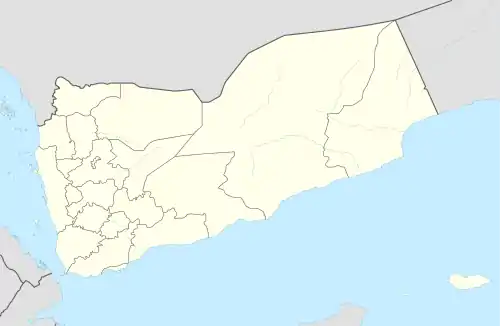Haddah
Haddah (Arabic: حدة Ḥaddah) is an affluent suburb of Sanaa, Yemen,[2] located about 8 km southwest of central Sanaa in Sanhan District of Sanaa Governorate.[3][1] It has been described as "the Beverly Hills of Sanaa" — a first-world enclave in a third-world city, with its avenues lined by palatial mansions belonging to the country's rich and powerful.[4] Its buildings mostly tend to emulate the architecture of Saudi Arabia and the Gulf states.[4]
Haddah
حدة | |
|---|---|
Village | |
 Haddah Location in Yemen | |
| Coordinates: 15.29294°N 44.16362°E[1] | |
| Country | |
| Governorate | Sanaa |
| District | Sanhan |
| Elevation | 7,933 ft (2,418 m) |
| Time zone | UTC+3 (Yemen Standard Time) |
History
Since the time of al-Hadi ila'l-Haqq Yahya, the first Imam of Yemen, Haddah was often used as a base of operations against Sanaa.[3] It was also frequently attacked from Sanaa.[3] An early mention in the Ghayat al-amani of Yahya ibn al-Husayn records that Haddah was the site of a minor battle in November or December of 901 CE (Dhu'l-Hijjah, 288 AH).[5] The battle was won by forces loyal to Imam al-Hadi.[5] The following year, al-Hadi sent a force, led by his son Abu'l-Qasim Muhammad and his own brother Abdullah, to Haddah and nearby Sana' (not the same as Sanaa).[5] They were attacked, but they were victorious and their attackers were routed.[5] Historical texts mention that Haddah's trees were cut down as punishment on multiple occasions.[3] One was in 1273 or 1274 CE (672 AH), when the Rasulid sultan al-Muzaffar Yusuf I razed Haddah and Sana' and cut down their trees.[5] Haddah still had many trees through the mid-20th century,[2] and was described in 1962 by Husayn ibn Ali al-Waysi as a favored picnic spot for Sana'nis,[5] but most of the trees were cut down in the 1980s as Haddah was built up into a suburb of Sanaa.[2]
References
- "Geonames.org. Ḩaddah". Retrieved 12 February 2021.
- Dresch, Paul (2000). A history of modern Yemen. Cambridge: Cambridge University Press. pp. 167–8. ISBN 9780521794824. Retrieved 15 February 2021.
- Wilson, Robert T.O. (1989). Gazetteer of Historical North-West Yemen. Germany: Georg Olms AG. p. 132. ISBN 9783487091952. Retrieved 12 February 2021.
- Clark, Victoria (2010). Yemen: Dancing on the Heads of Snakes. Yale University Press. pp. 124, 182, 260–3. ISBN 978-0-300-11701-1. Retrieved 26 January 2022.
- Eagle, A.B.D.R. (1990). Ghayat al-amani and the life and times of al-Hadi Yahya b. al-Husayn: an introduction, newly edited text and translation with detailed annotation. Durham University. pp. 148, 180–1, 183, 187. Retrieved 12 February 2021.